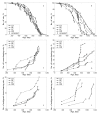Circadian disruption induced by light-at-night accelerates aging and promotes tumorigenesis in rats
- PMID: 20157558
- PMCID: PMC2816394
- DOI: 10.18632/aging.100092
Circadian disruption induced by light-at-night accelerates aging and promotes tumorigenesis in rats
Abstract
We evaluated the effect of various light/dark regimens on the survival, life span and tumorigenesis in rats. Two hundred eight male and 203 females LIO rats were subdivided into 4 groups and kept at various light/dark regimens: standard 12:12 light/dark (LD); natural lighting of the North-West of Russia (NL); constant light (LL), and constant darkness (DD) since the age of 25 days until natural death. We found that exposure to NL and LL regimens accelerated development of metabolic syndrome and spontaneous tumorigenesis, shortened life span both in male and females rats as compared to the standard LD regimen. We conclude that circadian disruption induced by light-at-night accelerates aging and promotes tumorigenesis in rats. This observation supports the conclusion of the International Agency Research on Cancer that shift-work that involves circadian disruption is probably carcinogenic to humans.
Keywords: life span; light-at-night; rats; tumorigenesis.
Conflict of interest statement
The author of this manuscript has no conflict of interests to declare.
Figures



Similar articles
-
Light-at-night-induced circadian disruption, cancer and aging.Curr Aging Sci. 2012 Dec;5(3):170-7. doi: 10.2174/1874609811205030002. Curr Aging Sci. 2012. PMID: 23237593
-
Circadian disruption induced by light-at-night accelerates aging and promotes tumorigenesis in young but not in old rats.Aging (Albany NY). 2010 Mar 20;2(2):82-92. doi: 10.18632/aging.100120. Aging (Albany NY). 2010. PMID: 20354269 Free PMC article.
-
Constant bright light (LL) during lactation in rats prevents arrhythmicity due to LL.Physiol Behav. 1998 Mar;63(5):875-82. doi: 10.1016/s0031-9384(98)00006-7. Physiol Behav. 1998. PMID: 9618011
-
Circadian rhythms, aging, and life span in mammals.Physiology (Bethesda). 2011 Aug;26(4):225-35. doi: 10.1152/physiol.00012.2011. Physiology (Bethesda). 2011. PMID: 21841071 Review.
-
Light pollution, reproductive function and cancer risk.Neuro Endocrinol Lett. 2006 Feb-Apr;27(1-2):35-52. Neuro Endocrinol Lett. 2006. PMID: 16648818 Review.
Cited by
-
Circadian disruption: from mouse models to molecular mechanisms and cancer therapeutic targets.Cancer Metastasis Rev. 2023 Mar;42(1):297-322. doi: 10.1007/s10555-022-10072-0. Epub 2022 Dec 14. Cancer Metastasis Rev. 2023. PMID: 36513953 Review.
-
A single night light exposure acutely alters hormonal and metabolic responses in healthy participants.Endocr Connect. 2017 Feb;6(2):100-110. doi: 10.1530/EC-16-0097. Endocr Connect. 2017. PMID: 28270559 Free PMC article.
-
Light Pollution and Cancer.Int J Mol Sci. 2020 Dec 8;21(24):9360. doi: 10.3390/ijms21249360. Int J Mol Sci. 2020. PMID: 33302582 Free PMC article. Review.
-
Gut microbiota as a transducer of dietary cues to regulate host circadian rhythms and metabolism.Nat Rev Gastroenterol Hepatol. 2021 Oct;18(10):679-689. doi: 10.1038/s41575-021-00452-2. Epub 2021 May 17. Nat Rev Gastroenterol Hepatol. 2021. PMID: 34002082 Free PMC article. Review.
-
The Sleep of Shelter Dogs Was Not Disrupted by Overnight Light Rather than Darkness in a Crossover Trial.Animals (Basel). 2019 Oct 14;9(10):794. doi: 10.3390/ani9100794. Animals (Basel). 2019. PMID: 31615005 Free PMC article.
References
-
- Arendt J. Melatonin: characteristics, concerns, and prospects. J Biol Rhythms. 2005;20:291–303. - PubMed
-
- Anisimov VN. The light-dark regimen and cancer development. Neuro Endocrinol Lett. 2002;23 (Suppl):28–36. - PubMed
-
- Anisimov VN. Light pollution, reproductive function and cancer risk. Neuro Endocrinol Lett. 2006;27:35–52. - PubMed
-
- Ha M, Park J. Shiftwork and metabolic risk factors of cardiovascular disease. J Occup Health. 2005;47:89–95. - PubMed
Publication types
MeSH terms
Substances
LinkOut - more resources
Full Text Sources
Medical
Research Materials
